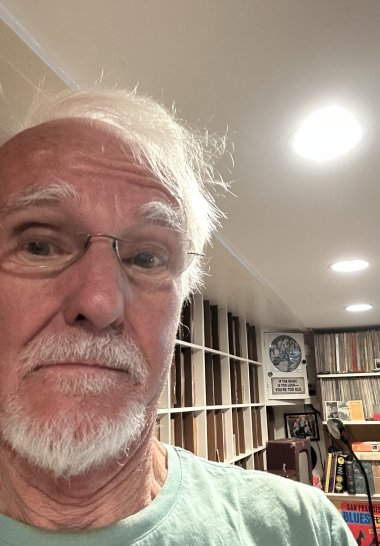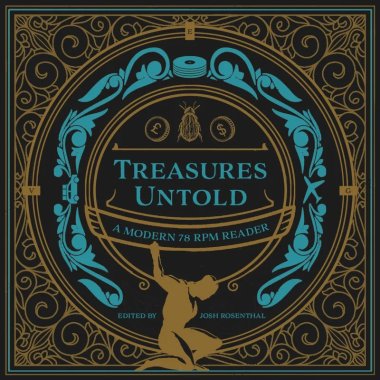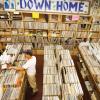
In the summer of 1980, on his first visit to the United States, British-born record collector Bob Bell realized his obsession had taken an unreasonable turn as he loaded his guilty acquisitions onto a bus.
Following a tip from a friend, he’d wandered into the back room at Village Music Record Store in Mill Valley, where he was quickly overcome by a feverish mania reminiscent of Humphrey Bogart striking a vein of gold in The Treasure of the Sierra Madre. CDs? We don’t need no stinkin’ CDs! Not when there are thousands of vintage 78-rpm records piled to the ceiling.
Bell recalls the experience some 45 years later in “The Lust for Shellac: Confessions of an Addict,” an essay in the recently published anthology Treasures Untold: A Modern 78 RPM Reader.

“Oh my god, the labels! Percy Mayfield on yellow-and-black Specialty, then Roy Milton on red Specialty, and then, look, Camille Howard on a black Specialty, but with much older art work,” writes Bell, calling roll for a roster of mostly forgotten indie purveyors of early R&B, blues, jazz, and emergent rock ’n’ roll: “Imperial, Cash, Money, Recorded in Hollywood, Dolphin’s, Savoy, King, Aladdin, Score, Fortune, Chess, Parrot, DeLuxe, RPM, Intro, DC, Comet, Exclusive, Excelsior, Down Beat, Swing Beat, Combo.”
Today, Bell sells records from many of the same labels at his site www.78crazy.com. But back then, the reality of his binge dawning on him as he exited Village Music, he quickly took stock of his entirely self-inflicted dilemma. “I had just purchased over 200 78s, weighing close to 100 pounds, more than I could comfortably carry, and I was hitchhiking,” he writes. “What had come over me?”
In one sense, Treasures Untold seeks to answer this question from a variety of angles. What sustains the allure of a format that became obsolete 70 years ago? What makes these objects so desirable for a small coterie of musical spelunkers in an era when cultural and economic currents have dematerialized the delivery of music?
Edited and put out by Grammy Award-nominated producer Josh Rosenthal, owner and founder of the San Francisco-based label Tompkins Square, Treasures Untold offers a fascinating look at collectors who ply junk stores, flea markets, estate sales, and eBay listings in search of rare 78s.
While 33-rpm vinyl reigns supreme in popular culture due to crate-digging DJs and the central role of LPs in hop-hop sampling and scratching, 78s were by far the dominant recording format from about 1910 until the late 1950s — which means that just about every 20th-century American musical idiom that coalesced before the election of John F. Kennedy was first documented on the 10-inch discs.
The masters for many of those seminal recordings were lost or destroyed long ago, so extant 78s aren’t merely copies of an original. They have become precious, irreplaceable repositories. “If you own an original 78, you own the master of that recording as it was (usually) originally intended to be heard,” Rosenthal writes (the italics are his). That’s a heady proposition when music companies have spent hundreds of millions of dollars buying artists’ catalogs.

Rosenthal is a surprisingly late bloomer when it comes to collecting 78s, a journey he details in his essay “You, And the Song.”
It wasn’t until he acquired several of the small discs that he realized “it’s a totally different experience than listening to an LP reissue of the same music,” he told SF Classical Voice in a recent conversation. “It added a new dimension, like finding a new hemisphere if you’re an explorer. On top of the sonic enjoyment, there’s the hunt, this fun quest that’s different than vinyl. There are different layers and ways to find stuff. The discovery process is deeper and more interesting.”
In addition to those essays by Rosenthal and Bell (the latter a music-business veteran who started working at Island Records in the mid-1960s and spent years managing the band Roomful of Blues), Treasures Untold includes contributions from nine other aficionados. Among them are banjo player, guitarist, vocalist, and producer Eli Smith (“Signal and Noise: 100 Years of Recording, From 78s to AI”); educator, author, producer, and musician Jerry Zolten (“Adventures in the Spin Game”); and 14-year-old collector and podcaster Jay Burnett (“I’m Wild About That Thing”). Burnett “can speak with authority about Abe Lyman or Barbecue Bob,” Rosenthal writes.

Rosenthal undertook the limited-edition book — and its companion CD, which features 10 covers of 78-era songs by artists such as Luther Dickinson, Eden & John’s East River String Band with R. Crumb, William Tyler, Muireann Bradley, Gwenifer Raymond, and Michael Hurley — as a vehicle to delve into his newfound passion.
“I really wanted to do the book so I could learn,” he said. “Asking these experts their perspectives, I was hoping I would gain some knowledge. [With] a lot of projects I create for Tompkins Square, I want to be the fan and create something I would be interested in. The downside is that the people in my orbit tend to skew in a certain direction in terms of what they like. It’s not the full picture.”
So listeners looking to learn about the 78 scene for opera, military bands, novelty numbers, minstrelsy, or the early music industry of Turkey will have to look elsewhere.
Ultimately, most 78 collectors swear by the sound quality. For the uninitiated, the discs are associated with scratchy sonics, pops, and distracting surface noise. But Bell swears by the experience of hearing music that was recorded with a particular format in mind.
“If you take a 45, a cassette, and a CD, a B.B. King recording from 1951 is going to sound the best on a 78, with fuller, warmer, richer sound,” he told SFCV.
Bell admits that he might be a little obsessive when it comes to matching recordings with gear. He’s taken to listening to 78s of a particular vintage on players that were manufactured around the same time — “which I don’t recommend, as collecting record players takes up even more space than 78s,” he said.
“Old wind-ups are heavy on the records, but playing acoustically recorded 78s on a wind-up isn’t a sin,” he continued, referring to the old-fashioned hand-cranked phonographs. “Those old records had an abrasive substance mixed in with the shellac to wear the needles before the needles wear the records.”
One needn’t start collecting Victrolas to recognize that the digital era has promulgated the widespread adoption of heavily compressed, lo-fi music. Collecting 78s might not be a realistic antidote for most people, but for some fans, savoring vibrations embedded in grooves a century ago is strangely comforting.
“Like so many things, I lay the blame on the PR men and ad agencies,” Bell said. “We’re always told that the latest thing is the greatest thing, to disregard previous iterations. Sure, 78s can be all scratchy and hissy, but if you get a pristine one — and there are more than you’d think — you’re getting close to the original source.”




